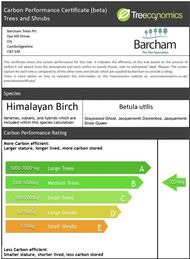 We often hear how trees contribute to the health of our planet and its climate. Frequently the discussion focuses on forests, their destruction, protection and creation. However, we can all make a difference by planting trees in our own garden. There is a wealth of research on how trees improve the urban environment. They provide shade, help manage our city temperatures and some species will reduce noise or pollution. On a global level it is their ability to absorb and store carbon as they grow. But are some trees greater carbon stores than others? Barcham Trees now publish eco tree tags for all the trees they sell. Using research commissioned from Treeconomics and based on the familiar format used for rating the energy efficiency of appliances, each tree gets a rating from A to E. Fascinatingly they also tell us the rate at which the carbon is stored across the tree's lifespan and the point at which it offsets the carbon produced to grow, deliver and plant it. Nervously, I thought I would look at the rating for some of my favourite trees which I often use in my planting designs. How would they score and would I need to rethink some of my choices? Luckily many, reflecting their similar garden-friendly dimensions, score a respectable C but the amount does vary from species to species. One of my favourites, the winter flowering cherry (Prunus "Autumnalis") will absorb 685kg of carbon across its lifetime, almost 30% higher than another go-to tree Amelanchier "Ballerina" at just 530kg. Both fall within Group C, but Autumnalis will offset its carbon footprint after just 12 months, whilst Ballerina takes a full three years. As a simple rule of thumb, the larger the tree the more carbon it will store. Does this mean we should all be planting big trees such as the chart-topping Eucalyptus gunii, scoring A and storing an impressive 7,570kg? Well. as always, the answer depends on the space you have available. If it's for your average urban garden then the answer is no. Barcham points out that a tree needs to grow well and to its full size if it's to store the maximum amount of carbon. Another reason to make sure that your chosen tree is suitable for the conditions and space available. I still feel comfortable with my favourites, but I have decided to bear in mind how a tree scores when including them in my designs. If I can achieve the desired effect with different trees, then their relative carbon scores will be a useful deciding factor. For more information on their eco tree tags and how they were developed click here.
0 Comments
Leave a Reply. |
Archives
May 2021
|